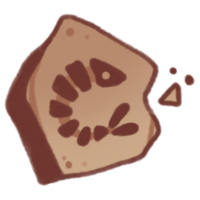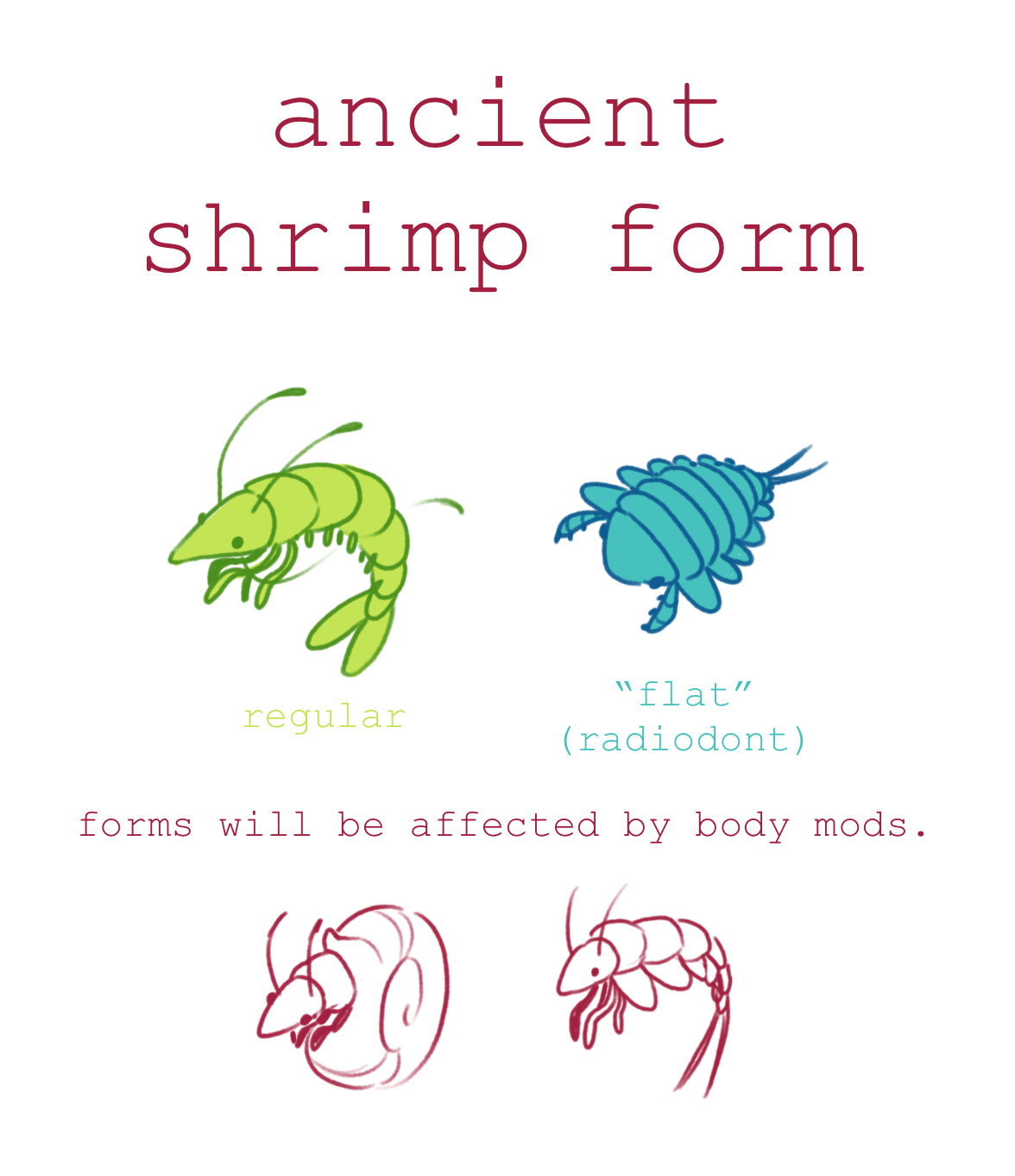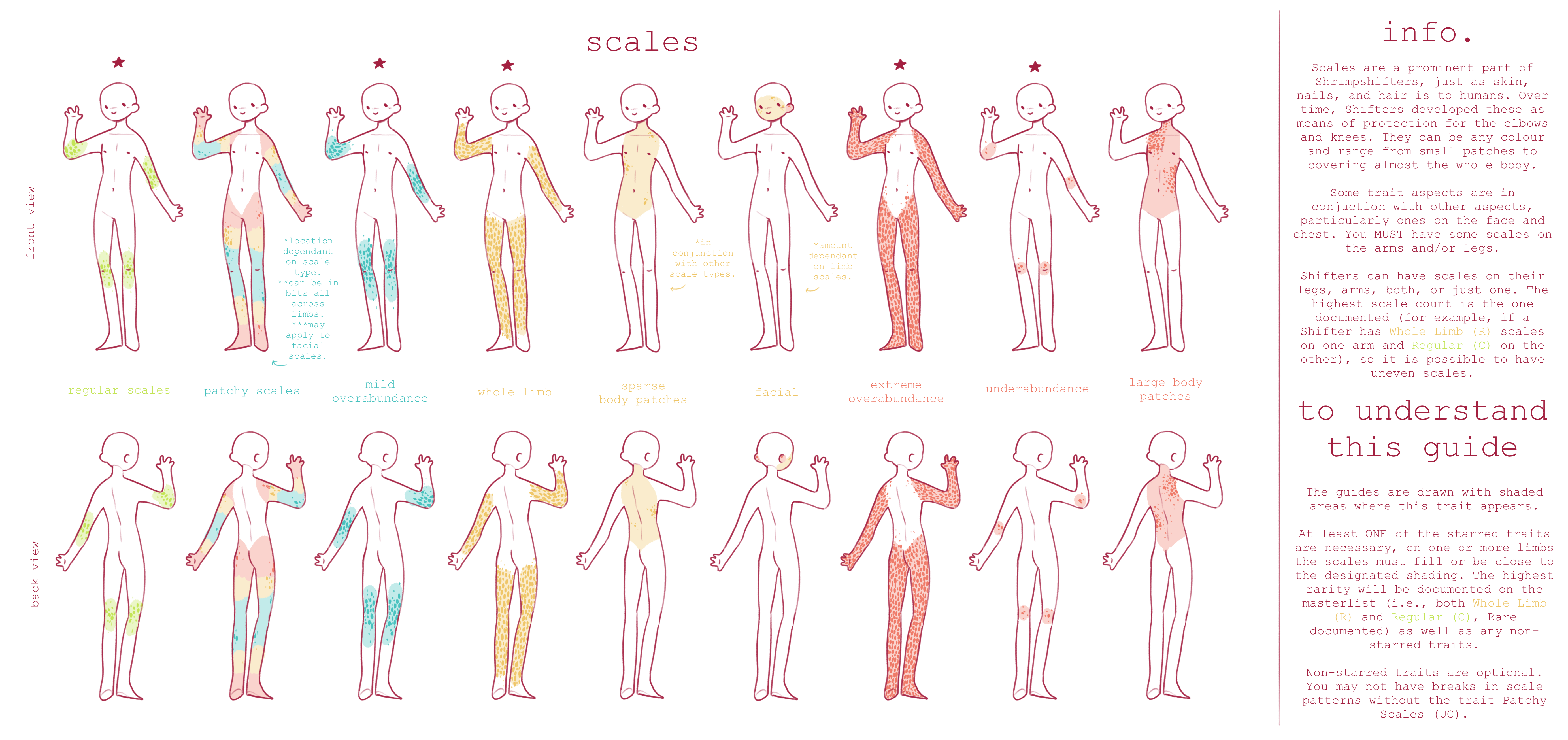If you're just looking for pictures, view the trait guides here! However, we recommend you read these descriptions to have a full understanding of the traits.
Please read the Trait Overview before you read this entry.
Ancients are Shifters who have been revived with the use of genetic technology and artifacts called Remnants. Because they are made from often random and sometimes incomplete genetic material, they are known for being frankensteins of multiple Shifters.
Ancients have some of the same body mods as normal Shifters, but also have some unique ones. They also can only breathe above land, or underwater, but not both (see: Lore > Anatomy).
Like normal Shrimpshifters, Ancients require scales and at least one body mod.
Wait, how can I get an Ancient Shrimpshifter? I don't see their MYOs in the shop. Participate during Events to receive Remnants. These can be cashed in at Theodosius' Laboratory, and you can get an MYO that way!
REMNANTS
"Remnant" is the term used in Aqualis for ancient genetic material, such as a fossil, pieces of bone, or other remains.
As items, you might see Remnants labeled as "Regular," "Deep Sea," "Lovely," or "Spooky." These are indicative of any extra trait sets you may be able to receive. A set of Regular Remnants will reward you with a normal Ancient with no add-ons, a set of Deep Sea Remnants will generate a Deep Sea Ancient, and a set of Spooky Remnants will create a Spooky Ancient.
Remnants can be found during scavenger hunt events, or as prizes. If you happen to see the icon below in the World, click on it and you may receive a Remnant!

CREATING AN ANCIENT (ROLLING INFORMATION)
You can create Ancients in the Laboratory, given you have enough Remnants. The minimum amount of Remnants you need to roll is 5. The more Remnants used, the higher the chances of the Ancient being Uncommon, Rare, or Legendary become.
If you use multiple different types of Remnants, you will have a varied chance of receiving one of the types. For example, if I used 3 Deep Sea and 2 Regular, I would have a 3/5 chance for a Deep Sea Ancient, and a 2/5 chance for a normal Ancient.
When an Ancient is put together, they have a chance of having Common, Uncommon, Rare, or Legendary traits. We randomize these combinations with the use of number generators.
ROLL CHANCES
Here are the base chances to receive these rarities:
Common: 60%
Uncommon: 30%
Rare: 8%
Legendary: 2%
Here are the improved chances, each by adding 5 Remnants. The last level is with a total of 20 Remnants.
Common: 25% > n/a > n/a
Uncommon: 50% > 25% > n/a
Rare: 15% > 60% > 40%
Legendary: 10% > 15% > 60%
Here are the mutation chances:
One Dual Body Mod: 30%
One Dual Limb: 30%
Two+ Dual Body Mods: 18%
Two+ Dual Limbs: 18%
Complete Split: 4%
ANCIENT TRAITS
If you would like to view some references for the inspirations for these traits, you can check out the order called Radiodonta. We wanted to have some more unique, and more predatory, inspiration; Radiodonts are actually not directly related to shrimp (but this is a fantasy world—so who knows)! You are also welcome to reference any other ancient crustaceans. Here are some specific images of Radiodonts we referenced: x / x
SHRIMP FORMS
Ancient Shifters have been documented in two types: a regular shrimp form, and what the scientists simply call a "flat" form. The Shifter isn't very dense, and usually has swimming blades instead of legs.

SCALES
All Shrimpshifters have scales either on their arm(s), their leg(s), or both, and some Shrimpshifters have scales on their chest or face (rare and legendary traits). Scientists believe they have these as a way of protection--after shifting back into a humanoid state, it's really easy to feel dizzy or disoriented, and the rocky shores aren't kind to falls. Scales may take up various portions of their limbs, be patchy, or only appear on one limb. It's even possible to have different types on each (the highest rarity/term is logged).

Common Scale Patterns
- Regular: the scales appear on the elbows and knees, and fade back into skin shortly after.
Uncommon Scale Patterns
- Patchy Scales: scales are not consistent across the limb, and appear in random patches with patches of skin showing in between.
- Mild Overabundance: there are more scales than normal across the limb, reaching around the thighs and calves, or the mid-point of the lower arm and bicep.
Rare Scale Patterns
- Whole Limb(s): the entire limb is covered by scales, usually encompassing the ankles, butt, wrists, and shoulder.
- Sparse Patches on Body: there are a few scales covering the torso, in small patches.
- Facial: small patches of scales on the face, usually on the cheeks or jawbone.
Legendary Scale Patterns
- Extreme Overabundance: there are so many scales on the limbs that they may cover, or come close to covering, the feet and hands, as well as trailing on the hips and collarbone.
- Underabundance: there are very little scales on the limbs.
- Large Patches on Body: across the torso, there are large patches of skin covered by scales.
HAIR
Although most Shrimpshifters have hair (common), not all do (uncommon). Shrimpshifters without hair do not have hair growth anywhere, including their legs, arms (and armpits), pubic areas, head, face, eyebrows, eyelashes, or even inside the nose! This doesn't come without a price, though, as it does remove the extra layer of protection body hair may provide (particularly for the eyes). In short, Shrimpshifters without hair do not have any hair follicles.

Many Shifters without hair get eyebrows tattooed on their face, and some wear scientifically-created false eyelashes that can help keep dust out of the eyes.

STITCHES & SKIN
Ancients have often have multiple types of skin on their bodies, due to them essentially being frankensteins. Common Ancients only have human skin tones.
Stitches hold the various pieces of skin together. They vary between each individual, and you may design them as you like. They can be sparse or frequent, hold together any number of skin types, and be as random or uniform as you prefer.
EARS
There are only three types of ears that Ancient Shifters have.
- Human (Common): regular, human shaped ears, made of cartilage.
- Swimming Blades (Uncommon): these Shifters don't actually have any cartilage, and have the same ear structure as Shifters with no ears, but they also have blades that decorate the place an ear would go. While the blades do a better job than modern fins do at projecting sound, they aren't quite as good as a normal auricle. They do look cool, though, and can somewhat help with swimming.
- None (Rare): while these Shrimpshifters can still hear, they are missing most of their outer ear: the auricle. Without this cartilage, they find it harder to hear; however, the muscular seal that covers their "ears" repel water significantly better (see: alligator ears).
ANCIENT BODY MODS


Common Body Traits
- Cranial Appendage (Ancient Antenna): Ancient Shifters often had thicker, structural antenna with small extensions called spines. These allowed them to be more tactile in their environments. These can curl, or be really large. For inspiration on Spiny Antenna, see these recreations.
- Facial Appendage (Ancient Whiskers): sometimes, instead of (or with) the antennas remaining, the whiskers do! Like Ancient Antenna, they may curl. For inspiration on Ancient Whiskers, see these recreations.
- Shrimp Tail: it's also possible for the shrimp tail to remain on the back of the Shifter. While they form their human legs, the shrimp tail doesn't always disappear. this shrimp tail may still have legs, or it might be just the tail, as the legs successfully translated. If the Shifter has Spines or Swimming Blades, they may decorate the tail. (sizing guide)
- Spines: Perhaps as an attempt to be less edible, Ancient Shifters also often had spines that both served as a defense and did an excellent job at sensing currents. These sometimes remain on the body, often rather malleable, and are typically spread on the back, head, and/or the undersides of arms and legs.
Uncommon Body Traits
- Bladed Tail: An Ancient variant of the Shrimp Tail, for Ancients that have a flat form. Just like the Shrimp Tail, it's also possible for a Bladed Tail to remain on the back of the Shifter. While they form their human legs, the shrimp tail doesn't always disappear. (sizing guide)
- Swimming Blades: Blades are a very effective tool for swimming, as the name suggests, and may appear on the back, head, and/or the undersides of arms and legs. "Blades" are not typically sharp, and are instead relatively malleable. They can be flexed using surrounding muscle that allows a Shifter to propel forwards in the water.
- Cercus Tail: A funny sensory appendage. It's a broad sweeping tail, typically 2, but there can be from 1-4.
- Horns: "Wait, horned shrimp are a thing?" Yep. Sometimes Shifters aren't able to shift these away, so they remain on their heads, or are translated to a pair of them. These horns don't curl, and they remain straight up; they are also fairly short (as a shrimp, the Shifter must have horns).
Rare Body Traits
- Crustaceous Shell: Only the torso is human, and the lower body never forms, remaining some sort of crustaceous shell. In shrimp form, the Shifter also has this shell. Although the Shifter would technically be able to climb from the shell, they could not transform back into a shrimp without it, and their legs are often incomplete and mangled into a shell-bearing shape, resembling more of a fleshy tail. Since the shell is typically pretty hefty in a humanoid state, these Shifters will also usually have blades to help them swim in water, especially if they are water-breathing. Shifters with this trait are usually missing or have incomplete sexual organs, and usually can't reproduce. Perhaps this genetic material is not from a Shrimpshifter at all...
- Exoskeletal Body: Pieces of the torso and pelvis might be made of a tough exoskeletal shell, just like a shrimp! Great for protection.
Legendary Body Traits
- Giantness: Typically lurking anywhere between 12 and 18 feet, this trait is what is left of an old race of Ancient Shifters that were incredible giants. Shifters with Giantness can only reproduce with other Giants, which is why the ancient race faded from existence. Ancient Shifters that are reformed in the laboratory with Giantness have varying heights depending on the amount of genetic material that carried over.
- Mermaid-Style Shrimp Tail: Only the torso is human, and the lower body never forms, remaining a shrimp tail. This tail may or may not have legs attached. While Shifters with this trait often have very elaborate and beautiful tails, they cannot transport themselves very easily, and usually rely on wheelchairs. Shifters with this trait are usually missing or have incomplete sexual organs, and usually can't reproduce.
- Mermaid-Style Bladed Tail: Only the torso is human, and the lower body never forms, remaining a bladed tail. This tail may or may not have either swimming blades attached, but they typically do. While Shifters with this trait often have very elaborate and beautiful tails, they cannot transport themselves very easily on land, and usually rely on wheelchairs (however, they made excellent swimmers!). Shifters with this trait are usually missing or have incomplete sexual organs, and usually can't reproduce.
MUTATIONS
Notably, Ancients also often have mutated genes that result in some odd trait combinations. There is a 4 in 5 chance your Ancient will have a mutation.
One Duplicate Body Mod: A duplicate set of body mods appear on the Shifter.
One Duplicate Limb: A duplicate set of limbs or appendages appear on the Shifter.
Two or More Duplicate Body Mods: Multiple duplicate sets of body mods appear on the Shifter.
Two or More Duplicate Limbs: Multiple duplicate sets of limbs or appendages appear on the Shifter.
Complete Split: When created, the active souls manifest into multiple bodies. If you roll this, you may roll again to see if the Shifters have another mutation (optional).
MISSING PARTS
Ancients don't come out complete, which is why they're combined with other pieces of other people. However, if something were to happen at the lab, and the Ancient wasn't finished, well... there might be something missing.
Example Ancients with this trait: Prismarine